The scope of commerce has broadened significantly with the advent of the internet. But it does not stop at e-commerce only, as we are now getting privy to social commerce. Over the past decade, India has seen a deep internet penetration, with social media becoming increasingly relevant. Due to the availability of low-cost data packages, people from all walks of life are now on various social media platforms, and as a result, these platforms are not only capable of providing visibility to brands, but also giving an opportunity for sale. Therefore, social commerce, where social media platforms play a crucial role in the entire shopping experience (right from product discovery and research to the checkout process), is getting increasingly important for brands across all categories. In social commerce, the consumers can also directly interact with the brands and that actually makes them feel engaged.
According to industry-insiders in India, social commerce market is estimated at $2 billion at present, and is expected to grow at a CAGR of 50-60% in the next 5 years.
Sharukh Lakhani, AVP – Marketplace, Havas Media Group India says, “Globally, the social commerce market is estimated to have grown 2.5 times i.e., $1.2 trillion from roughly $490 billion over the past few years. This market in India is estimated at $2 billion at present, and is expected to grow at a CAGR of 50-60% in the next 5 years.”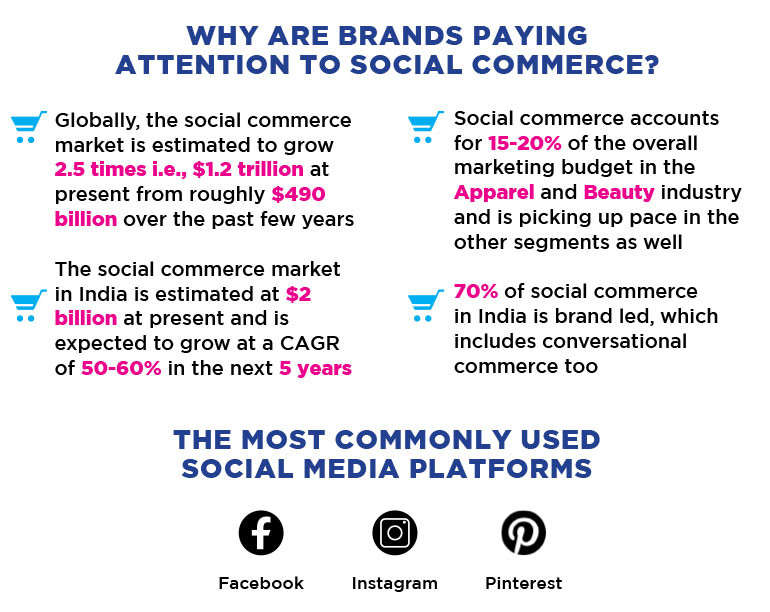
These numbers are anything but surprising, given the fact that more and more people are joining social media with each passing year. It is estimated that almost 70 percent of India’s population is actively using social media today.
Vishal Jacob, Chief Digital Officer, Wavemaker India says that social commerce is being used by brands across categories. “However, categories such as beauty & personal-care, fashion & lifestyle were the early adopters, and they have been scaling steadily. Categories such as F&B (Food and Beverage) and travel have also started using social commerce in a significant way,” he says.
“In India, social commerce can be brand led, community led and Key Opinion Leader (KOL) led. 70% of social commerce in India is brand led, which includes conversational commerce too (source: Essence report). The primary reason for brands to use social commerce is to hasten the consumer journey from inspiration to purchase, and to address any communication barriers around consideration. Another reason is to tap and influence new users in non-metro markets, where social media platforms are able to do quite well,” Jacob further says.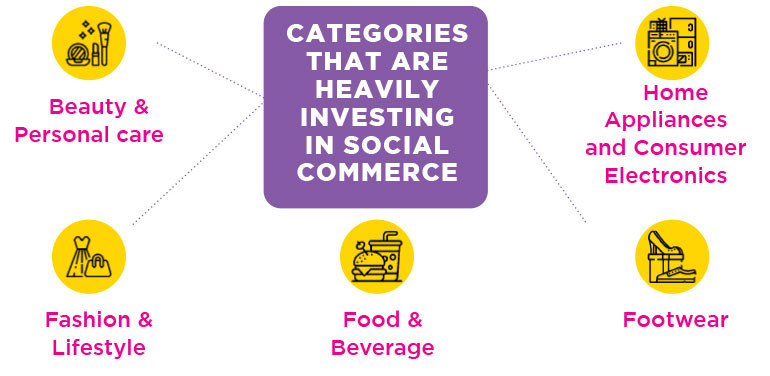
In a country where the number of social media users is expected to reach almost 1.5 billion in the year 2040, the purpose of social commerce is undeniable. Reaching out to non-metro markets through social commerce is perhaps one of the most efficient tool of marketing. Brands can now woo customers from any part of the country.
Dhruv Madhok and Dhruv Bhasin, Cofounders, ARATA say that 40-50% of their budget is spent on creating ads for social commerce. “Our primary target audience is active on major social media platforms and hence, converting them into potential buyers is easier. Social proofing (reviews, feedback, etc.) also really helps. The customers are getting smarter, and they read reviews before making the final purchase. Also, user recommendations and referrals are key in converting our target prospects into actual brand buyers. 40-50% of our budget is spent on creating ads for social commerce. We consistently scale a marketing budget by 10-15% each quarter,” they say.
“We have chosen Instagram, Facebook and YouTube as our key channels for social commerce as we can target the right set of audiences there. As far as modern technologies are concerned, we are using CRM retention tools, Whatsapp AI Bots, and Automated Retargeting campaigns for our social commerce activities. E-Commerce channels contribute around 40% of our sale, and the contribution of social commerce to that (40% sale) is 20-22%, majorly by acquiring new users,” they add.
According to a report titled, ‘State of Influencer marketing in India 2021,’ by AnyMind Group, YouTube is the most-used social media platform in India. While, Facebook and Twitter saw a major rise when compared to other social media platforms during 2020-21.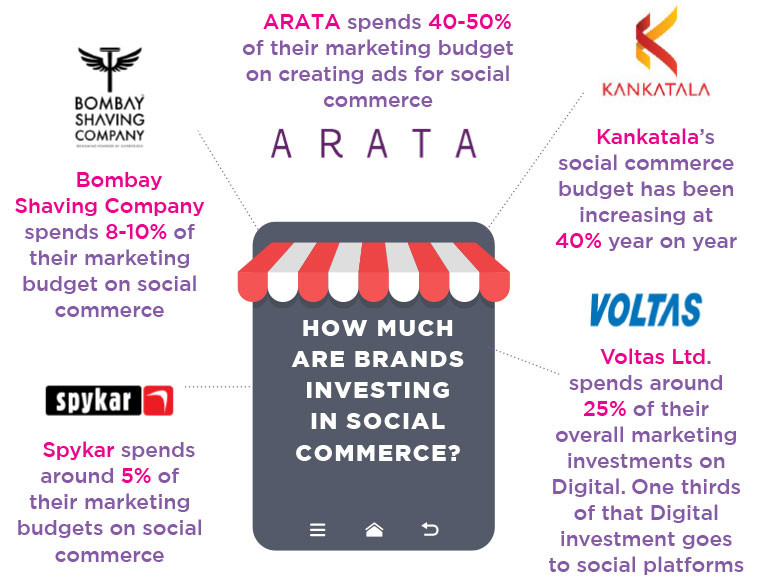
Ritika Arora, Senior Director, E-commerce and New Brands at Bombay Shaving Company says, “Quite a few social commerce sites have good presence in tier 2 and tier 3 cities, and those are the convenient mode of shopping for customers there. For example, in southern India – where we scaled up retail distribution recently - social commerce has proven to be a good way of reaching out to the customers. As we venture into women’s grooming and hygiene category, a whole new user base has opened up on the existing channels. Hence, the impact of social commerce is felt when the business strategy is aligned with the inherent nature of the platform.”
“Around 50% of our current business can be attributed to e-commerce. The contribution of social commerce to that business (50%) is around 20%, periodically. For us, social commerce works better, when leveraged and scaled well on channels during events and on certain occasions. We spend 8-10% of our marketing budget on social commerce,” she says.
With the emergence of new home-grown brands promising better quality, and conscious products, social media has become the playing field for their outreach. It is through social media that brands are getting in touch with their target audience, and finding their ground in a booming market space. To have customer reviews, ratings, discussions, and more, contribute immensely to the growth of a brand.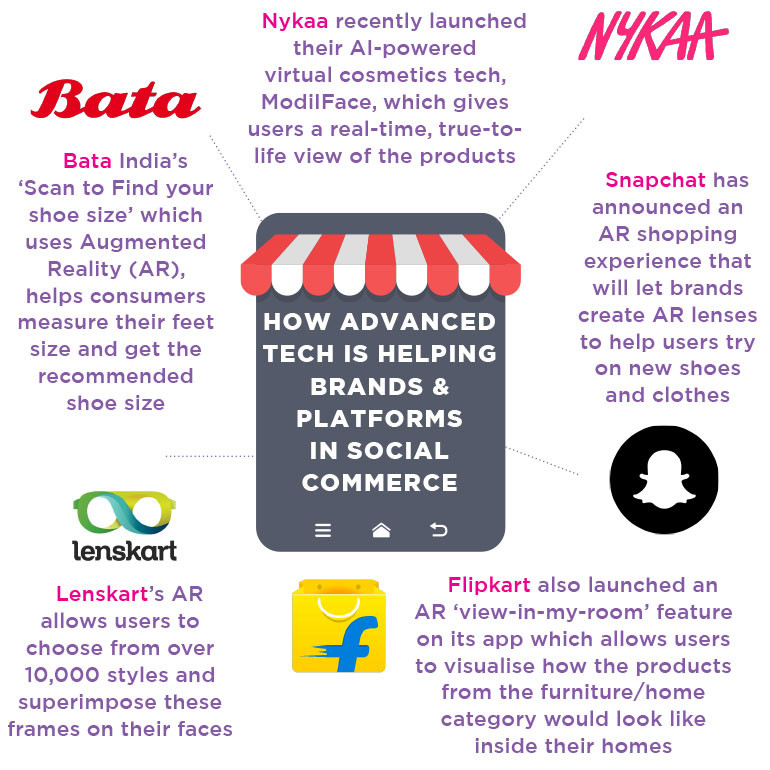
Abhishek Agrawal, Chief Business Officer at Plum says, “In social commerce, the direct conversation with consumers helps a brand market their products in a much more convincing manner than the traditional way of selling online. Secondly, a whole lot of content is automatically produced, which the brand would otherwise not be able to create on its own. The feedbacks about the products that comes from influencers and customers are rich and received in real-time.”
“We are present on Instagram, Facebook, and YouTube, apart from using Trell and Foxy. We are also leveraging the recently rolled out live commerce features on our website plumgoodness.com. We have an in-depth understanding of what assets work for which TG, and on the basis of that we deploy creatives, videos and influencers. Platforms such as Facebook and Instagram play different roles and hence, assets deployed on them are different. We also work with Google through GDN, Paid Search and YouTube. For us, social commerce will play a key role in bridging the gap between the approximately 160mn people transacting, and the 600mn people who are present online.”
Experts believe that social commerce is not just e-Commerce advertising on social media. Anisha Iyer, CEO, OMD India says, “In social commerce you need to have a proper content strategy woven around product sales. As far as content marketing is concerned, it doesn’t focus on selling, it usually focuses on engagement. But in social commerce, there is an opportunity to do content marketing with a focus on selling. Therefore, social commerce should not be looked at as an e-Commerce marketing platform. It should be considered more like an extension of a brand’s content strategy and less of a media strategy.”
It is no secret that today people have become homebodies, thanks to the pandemic and the new normal of staying indoors. Therefore, there is a growing need for social commerce. Leading E-Commerce companies are already making their way into social commerce. Interestingly, social media platforms too are ready to accommodate social commerce features for the ease of business. In 2020, Facebook had added new tools to help make social commerce a success. WhatsApp’s Business Profile allows users to find a shop from the app directory, a feature that was launched in Brazil in 2021.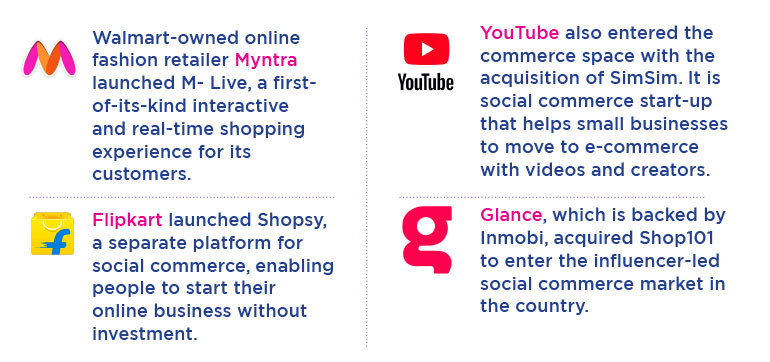
Certain brands got into social commerce in the middle of the Covid-19 pandemic as their offline businesses were totally shut then. Even as it did well for them during that time, they are still in a ‘wait and watch’ position to take the next course of action.
In the fashion category, Spykar is one such brand. Sanjay Vakharia, Co-founder and CEO at Spykar says, “We started social commerce in mid-2020. It was absolutely required during that time and it did well for us. However, the Covid- 19 period was a different time and hence, we are yet to take major decisions about it. We would like to see the trends of social commerce for a year in a non-Covid period. In that sense, the calendar year of 2022 is going to be very crucial for us. Based on the results of this year, we can be much more aggressive or more conservative in social commerce in 2023.”
Vakharia says that they are present on Facebook and Instagram, and 70-80% of their campaigns are led by influencers. The static campaigns are few in numbers. “Presently, 18-20% of our business is coming from e-Commerce and out of that 10-12% is coming from social commerce. We are spending around 5% of our marketing budgets on social commerce.”
Prominent saree brand, Kankatala, on the other hand, seems to be quite decisive about it. Their social commerce budget has been increasing at 40% year-on-year. Anirudh Kankatala, Director at Kankatala says, “We started social commerce at the end of 2016 because we had noticed that consumers were rapidly getting into social media, and that several new social channels were emerging. Many multinational companies in this industry were succeeding by using those platforms and we recognized a similar opportunity there. We started with Facebook and then moved to Instagram shortly. Apart from these two, we are now on Pinterest too.”
“We believe that our customers are our finest ambassadors. Therefore, we refer to them as ‘Queens’ of our brand while posting their photos in our client diaries. We also do quarterly collaborations with social media influencers and we run frequent campaigns to promote the beauty of Indian weaves on all of our social media channels,” he says.
According to Anisha Iyer, CEO, OMD India, the world of social commerce will undergo changes with the coming of advanced technologies such as Metaverse or Virtual Reality (VR). She says, “Such technologies will definitely change the experience of social commerce. For example, if we have a lipstick to sell today, we will get an influencer wearing that lipstick, and she will show various shades on a video or a reel. With the coming of Metaverse or VR, suddenly you will be inside the universe of a fashion show where you will see women doing ramp walk wearing different shades of that lipstick. Whichever shade or sample you like, you will be able to purchase it. So, it will enhance the experience of the consumers. But I don’t think that it is going to dramatically change the fate of the brands unless they do something really big in it and customize the brand experience.”
It is easy to see the attraction towards augmented reality when it comes to social commerce. While e-commerce sites allow customers to take a close look at a product without getting into the store physically, with augmented reality, customers can even try out products virtually. There is a far better understanding of what the actual product is like. In February 2021, IKEA Studio created shoppable AR ‘escape room’ game on Snapchat, a fun way to get out of the clutter, and take charge of your homes. In this game, customers could point their phone’s camera anywhere to find a cluttered augmented 3D room. The objective was to declutter the room.
Bata India says that apart from using some advanced technologies such as AR and AI, they are also in a process of launching a few new use cases of VR and AR. Anand Narang, VP-Marketing and Consumer Experience at Bata India Limited says, “We have a service, ‘Scan to Find your shoe size,’ which uses Augmented Reality (AR) to help consumers measure their feet size and get the recommended Bata shoe size. Consumer can use this sitting at home before ordering their shoes from bata.in. In our loyalty programme, we use Artificial Intelligence (AI), data science and predictive analytics to recommend the next best product to consumers. We are also working on some interesting use cases of VR and AR and will launch them in due course.”
“Social commerce offers a lot of benefits today, from increased customer engagement to making sense of customer insights to enhancing audience growth. We want to make shopping easy and convenient for the customers and that is exactly where social commerce fits in really well in the larger scheme of things. For this, we have multiple channels – Bata Chatshop, a WhatsApp shopping channel, social channels (Facebook, Instagram), Google Shopping and CRM channel. Currently, the sale on Digital channels contribute to 10-15% of our overall sales. Depending on the month, our Digital spends vary between 25-30%,” he says.
Sharukh Lakhani, AVP – Marketplace, Havas Media Group India says that of late, several other companies have adopted the latest technologies and that has transformed the overall shopping experience to a great extent. “Snapchat has announced a new AR shopping experience and it will let the brands create AR lenses to help users try on new shoes and clothes. Puma and Ralph Lauren will also be seen partnering on this for the initial testing which will be rolled out for other brands eventually. Nykaa recently launched their AI-powered virtual cosmetics tech, ModiIFace, and that gives users a real-time, true-to-life view of the products. Lenskart’s AR allows users to choose from over 10,000 styles and superimpose these frames on their faces. Flipkart also launched an AR ‘view-in-my-room’ feature on its app which allows users to visualise how the products from the furniture/home category would look like inside their homes.”
Dabur India Ltd. says that the advanced technologies have come as a big help to them. Smerth Khanna, Business Head- Ecommerce, Dabur India Ltd says, “You will find a lot of conversations on the internet about a brand, the areas of concern, global trends etc. So, the task of any brand is to ensure that they distil the voice from the noise. With AI in place, the entire Online Reputation Management (ORM) has become very easy. You can go and delight the consumers, if there is an ambiguity with respect to your brand. Almost 80% of the queries can be answered through it and that’s what we are doing. We are also using AR to a great extent, and are even exploring the VR route for some of our new launches.”
“If you see earlier there was the concept of market share. The companies used to track their success rates through their market shares. But now there is a battle between market share and mind share. Today mind share is actually driving the market share, and mind share is taken care of by social commerce. So, it is very important for a brand to ensure that the mind share is on top and that’s why social commerce is getting so much importance. Of our total turnover, a very high single digit percentage is now coming from e-Commerce. The contribution of social commerce is low at present, but it is catching up at a very fast pace. For us, the pace of social commerce is faster than e-Commerce,” he says.
Even though we are at a juncture where we seem to be evolving from e-commerce to social commerce as a whole, brands are mostly targeting young people with this new form of marketing. The fact that young people are more confident with the internet and all of its different aspects, boosts the practical application of social commerce. It further helps if the brand in question is a new-age brand, and of course, indigenous.
Voltas Ltd. says that social commerce has helped them in tapping the Millennials and GenZ population, who have a significant presence on social media platforms. Deba Ghoshal, Vice President and Head of Marketing, Voltas Ltd. says, “We rolled out our summer campaign ‘Ghar le aao, pahadon wali saaf hawa’ around its new range of PureAir ACs on our social media platforms. The campaign was designed to communicate the message that the new AC is designed to provide cool, pure and clean air (like mountain breeze), in the comfort of one’s home. We are present on all digital platforms, including social media platforms such as Instagram and Facebook.”
“Digital outlays are approximately 25% of our overall marketing investments. The investment on social platform is around one-third of our digital outlays. We always create content and campaigns related to topical days and try to make an emotional connect with our customers through our posts. We believe that starting a conversation on topical days will give our brand the leverage to understand our customers better,” he adds.
For Rage Coffee, social commerce is about meeting the customers where they are. Bharat Sethi - Founder & CEO - Rage Coffee says, “The Ragers community that we have curated, is very active on social media and therefore, it makes social commerce an extremely suitable platform for us. Instagram and Facebook have been our preferred platforms. Instagram is where we communicate directly with the Ragers community, raising awareness on coffee, introducing new products, exchanging knowledge and recipes, and optimizing the coffee experience. We collaborate with influencers across platforms to evaluate our products and exchange their honest feedback with communities that have similar interests.”
“The business model of Rage Coffee comprises 50% offline and 50% online operations. The online operations can further be split into direct website sale, which account for 75% of the total numbers, whereas a quarter of sale comes from social commerce, hyper local apps, and the marketplaces. We have a chatbot. The direct interactions on social commerce and chats make the user’s journey simpler, more transparent, and more convenient. By choosing a couple of options there, customers can bypass browsing and searching in the product catalogues and go directly to the checkout page.”
There is nothing quite like sitting in the comfort of your home, window shopping, and contemplating a purchase. This has perhaps become a norm today since the COVID19 pandemic has forced us to embrace digital and the indoors. Brands were quick to respond, adapting to the change, answering to the demand, and here we have an all new era of commerce.
E - PAPER
COMMERCE TURNS SOCIAL
This holiday, interactions between brands and consumers became more resolute through social commerce, which is expected to grow by 50-60% in the next five years
 BY
PRANAB JYOTI BHUYAN
BY
PRANAB JYOTI BHUYAN
Published: Dec 27, 2022 3:48 PM
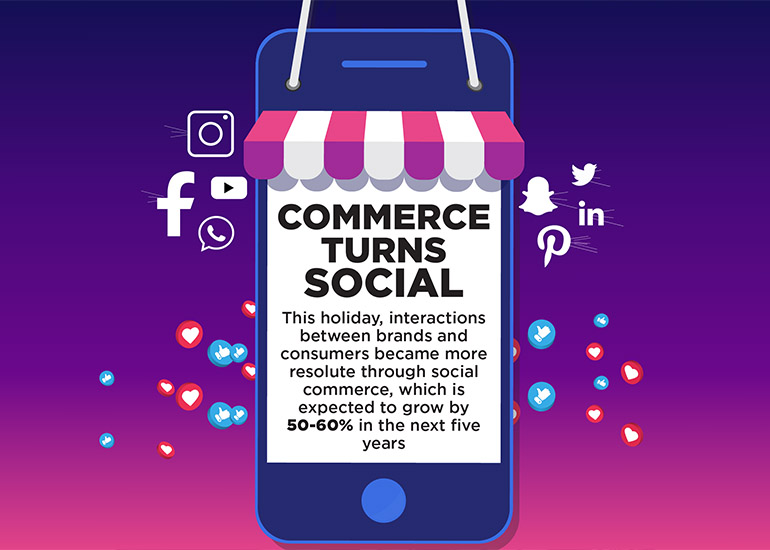
TOP STORY

Best Ads of December 2025
As 2025 closed, brands chose restraint over noise. Here are Impact’s picks of the most thoughtful campaigns of December 2025
NEWS LETTER
Subscribe for our news letter
Subscribe To Impact Online
IMPACT SPECIAL ISSUES

Suniel shetty takes the Spotlight
Miked Up for Goafest
Get Set Goaaa!
Anupriya Acharya Tops the IMPACT 50 Most Influenti
Advertising Turbocharged
A Toast to creativity
GOAing towards tech-lead creativity
REDISCOVERING ONESELF
50 MOST INFLUENTIAL WOMEN LIST 2022
BACK WITH A BANG!
Your Best Coffee Ever
PR Commune Magazine June-July 2022
13th-ANNIVERSARY-SPECIAL
PR Commune Magazine April 2022






